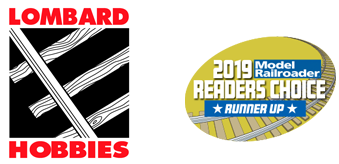ScaleTrains N
ScaleTrains Rivet Counter N SXT39352 Pullman-Standard 5820 Covered Hopper Pullman Transport Leasing/Lauhoff PTLX #41984
- In Stock:
- 2
- Scale:
- N
- SKU:
- SXT39352
Description
Please note picture is representative of the item but may not be same road number. Always refer to product description for actual product details.
ScaleTrains Rivet Counter N SXT39352 Pullman-Standard 5820 Covered Hopper Pullman Transport Leasing/Lauhoff PTLX #41984
Road Number Specific ScaleTrains
- All-new model
- Era:1973 to Mid 1990s
- Series 41940 to 41989; built 6/73, P-S Lot 9524A
- Fully-assembled
- Multiple road numbers
- Late body with 19 posts with lower notches in post; clerestory roof
- Without end vents
- Photo-etched stainless-steel see-through Apex (slotted) roofwalk with metal grab irons
- Mon-o-wheel roof hatches
- Photo-etched stainless-steel see-through Apex (slotted) coupler crossover platforms
- Outlet bays without Shaker Brackets
- Micro-matic pneumatic outlet gates
- Complete underbody brake system with over 10 separately applied parts including air reservoir, control valve, retainer valve, and wireform plumbing
- ASF Ride Control trucks with finely rendered raised foundry data
- 36” machined metal wheels
- Body-mounted semi-scale standard Type E knuckle couplers – Micro-Trains compatible
- Printing and lettering legible even under magnification
- Weighted to Industry standards for reliable operation
- Operates on Code 55 and 80 rail
- Clear jewel box packaging safely stores model
- Minimum radius: 9 ¾”
- Recommended radius: 11”
Prototype History:
The raw plastic that is used in industrial settings is typically produced from petrochemicals and made in a variety of grades and compositions to suit different applications. The raw plastic is typically shipped in the form of small granules or pellets. For producing most items, raw pellets are taken in by the end-user where they are heated until they are molten, have any necessary dyes or additives added for a desired final color and properties, and injected under extremely high pressure into molds for the final product. Like so many commodities, plastic pellets lend themselves well for rail transport, which has led to the development of numerous car designs over the years to handle this important commodity.
The covered hopper car has proven to be the ideal design for carrying plastic pellets and is well-suited for their density and handling characteristics. While plastics cars in the early 1900s were typically conventional covered hoppers of the era, by the 1960s specialized car designs were developed. Compared to covered hoppers intended for grain products, plastic pellet cars were often physically larger – owing to the low density of the plastic pellets and the desire to utilize higher car tonnage ratings. Smaller, round loading hatches are also common, being easier to seal and keep out contaminants. Outlets are specialized as well, typically being pneumatic designs that allow hoses to be attached to the outlet and use a vacuum to draw the lightweight pellets out of the car bays.
Pullman-Standard was one of many legacy domestic car builders that would introduce a design intended to serve the plastics trade. Drawing heavily upon existing grain hopper designs in their catalog, Pullman-Standard introduced a 5820cf capacity car in late 1971. Designed with plastics products in mind, these exterior-post cars were imposing, featuring four bays, and a length of nearly 70 feet over the couplers. The earliest versions featured a peaked roofline and 17 exterior posts per side.
Later versions adopted the trademark P-S 'clerestory' roofline that was also utilized on their landmark 4750cf grain hopper, as well as a revised side panel construction utilizing 19 posts. Initially, the posts featured a small triangular notch at the bottom before switching back to a solid-bottom design. Also reflecting a family appearance with other designs in the P-S catalog, such as the 4785cf covered hopper, all of the 5820cf cars featured vertical structural shear plates on the end sills.
The P-S 5820cf covered hopper proved to be a popular design, with a large number built for a number of private owners, as well as Pullman-Standard’s lease fleet, between 1971 and 1982. While the oldest 5820 cars have been withdrawn from interchange service by now, having reached their 40-year age limit, cars built after July 1st, 1974 are allowed 50 years of service, and up to 65 years if they meet “Increased Service Life” criteria. And like most car designs, the 5820s have exhibited changes over their service lives, mostly to their hatches and outlets.
As-built, most were equipped with P-S / ITEL Corp. proprietary “Micro-Matic” pneumatic outlets and either “Mon-o-Wheel” or “Tri-Wheel” roof hatches. As these components wore out, they would often be replaced by aftermarket replacements, such as Salco-brand Kam-Op pneumatic outlets. Salco also offers a popular line of replacement hatches for these cars, either plain or vented, which helps negate the need for personnel to climb onto the car running boards to open hatches for venting while unloading.
Operationally, they tended to congregate in petrochemical production regions waiting for loading (e.g., the Texas “Chemical Coast”), but were – and still are – seen traveling nationwide in singles or in blocks of cars heading to production facilities for items ranging from plastic milk jugs to fiberglass panels. Interestingly, they can also be seen staged at plastics logistics yards where huge blocks of loaded plastics hoppers are parked, with pellets bought and unloaded as needed onsite by the customer using tractor-pneumatic tank trailer rigs, essentially making the cars rolling warehouses.
Lombard Hobbies - Modelers helping Modelers for over 40 years!





























